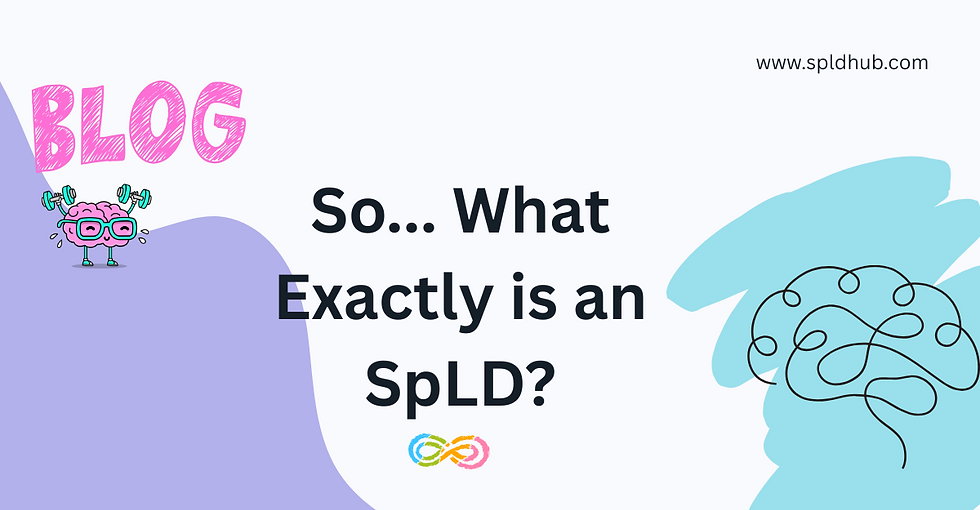🧩 So… What Exactly is an SpLD? 🤔🧠
- Emma Stokes
- Jul 28
- 2 min read
Updated: Aug 6

An SpLD (Specific Learning Difficulty) affects how someone learns and processes information in particular areas — despite having average or above-average intelligence.
The word “specific” is key: unlike general learning difficulties, SpLDs impact one or more specific aspects of learning. They’re neurodevelopmental in nature — meaning they relate to how the brain is wired — and they often run in families.
Some of the most recognised SpLDs include:
Dyslexia – affecting reading, spelling, and language processing
Dyscalculia – affecting number sense and mathematical understanding
Dyspraxia (DCD) – affecting coordination and fine motor skills
ADHD – impacting attention, impulse control, and executive function
Irlen Syndrome/Visual Stress – affecting how visual information is processed
It’s also very common for SpLDs to overlap. A child with dyslexia might also show signs of ADHD, or struggle with maths in a way that suggests dyscalculia.
Why does this matter?
Too often, learners with specific learning difficulties (SpLDs) are misunderstood — labelled as lazy, distracted, or simply not trying hard enough. These assumptions are not just unfair; they’re damaging.
Without the right recognition and support, SpLDs can lead to:
😔 Low self-esteem
🚪 School or workplace avoidance
😟 Anxiety and depression
❌📚🤝💼 Missed opportunities — academically, socially, and professionally
But it doesn’t have to be this way.
When SpLDs are properly identified and supported, we unlock potential. With the right strategies, tools, and understanding, learners of all ages can thrive — not in spite of their differences, but because of the unique strengths those differences bring.
What does support look like?
There’s no one-size-fits-all answer, but the good news is: there are lots of options. Here are a few of the most common ways we support neurodivergent learners:
🧠📋 Assessment – A diagnostic assessment identifies the nature of a person’s difficulties and their strengths, offering clarity and guidance.
👩🏫✨ Specialist teaching – Tailored support from trained professionals (like myself) can build specific skills and confidence.
💻🗣️🖊️ Assistive technology – From reading pens to voice-to-text apps, technology can reduce barriers and promote independence.
🏫💼🔧 Classroom or Workplace adaptations – With the right support in place, neurodivergent individuals can fully engage with the curriculum or job role, removing unnecessary barriers to success.
💡🪞🤝 Understanding and self-awareness – Perhaps most powerfully, a diagnosis can help someone understand how their brain works — not just in learning, but in everyday life. It can bring clarity, reduce self-blame, and show that they’re not alone.
Moving forward
SpLDs are not flaws to be fixed — they’re differences to be understood and supported. And understanding starts with awareness. Whether you’re navigating your own learning journey or supporting someone else’s, the right information makes all the difference.
I’ll be using this blog to explore common questions around SpLDs, share practical strategies, and offer insight into assessment, support, and everyday learning.
If you’ve ever thought, “Something isn’t adding up — but I don’t know what it is,” you’re not alone. And you don’t have to figure it out by yourself.



